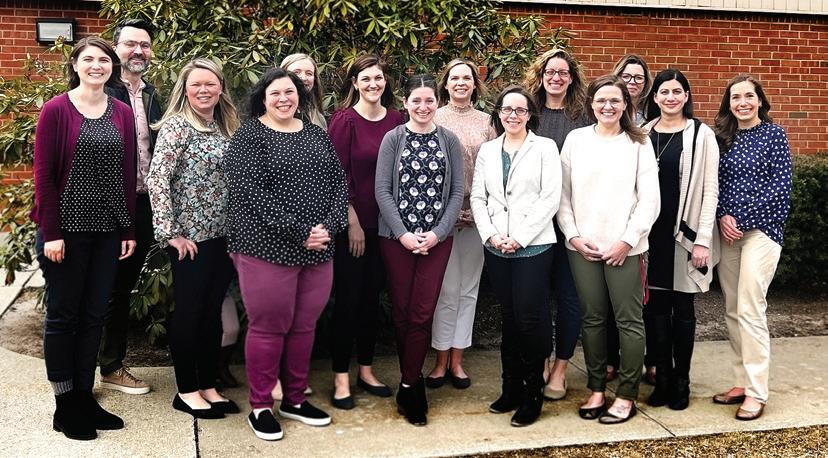CONNECTIONS
From Northeastern Connecticut
EASTCONN Magnet Schools Lead Way on Grading for Equity
EASTCONN’s two magnet high schools – Arts at the Capitol Theater (ACT) in Willimantic and Quinebaug Middle College (QMC) in Danielson – have adopted a personalized, competencybased approach to teaching and learning.


In doing so, EASTCONN joined a handful of Connecticut school districts leading the way on grading for equity statewide.
“When you think of Connecticut’s education system, we’ve been recognized as being a high-achieving state, but we’ve also been recognized as having a high achievement gap,” said Sarah Mallory, principal at ACT. “Competency work is designed to get rid of that gap and to equalize the playing field, because all students need to demonstrate their learning to the same set of standards.”
See Reform, page 2
Q&A with Mr. Edward
After an extensive screening process, veteran educator Edward “Ted” Keleher was selected to lead EASTCONN’s Quinebaug Middle College as its new principal. Ted most recently served as a successful and innovative high school principal at Robert E. Fitch High School in Groton. Before

“Ted” Keleher, Principal at Quinebaug Middle CollegeACT Principal Sarah Mallory (left) with EASTCONN Education Specialists Kristin Stryker and Dr. Evan Krawiec. QMC’s new principal Edward “Ted” Keleher
Competency-based – also known as mastery-based or proficiency-based – education attempts to shift classrooms from school-centered to student-centered approaches, which more successfully prepare teenagers for the rapidly changing needs of colleges and careers.
How it works: teachers and administrators collaborate to identify essential standards for each class offered to students. Over time, teachers communicate student progress in PowerSchool by adding standards and “tagging” them within each assignment, allowing students and families to monitor progress and to see where they are in terms of meeting each standard.
When they receive their report cards, students and parents see words like “Exemplary,” “Mastery,” “Progressing,” “Beginning” or “Insufficient Evidence,” which are easily converted to grade point averages (GPAs) commonly used by colleges and universities.
Hearing the word “competency,” however, is when people start to get foggy. Simply put, competencies are statements developed from the standards about what students will know and be able to do.
“Right now, if you looked at some of our math courses, for example, there are around 15 standards in there that they’re working towards,” Mallory said. “Competencies combine multiple standards into one statement. It makes it more transferable for students and families to understand versus the long list of 15.”
Thomas R. Guskey, Ph.D., in his book “Developing Standards-Based Report Cards,” reflects on grading practices in education that are rooted in the early 1900s, when percentages and letter-grade scales first came into widespread use in schools. Guskey argues that our practices have not kept pace with what research tells us about effective grading; grades should reflect learning, be consistent between teachers and be rooted in summative assessments.
Dr. Evan Krawiec, Education Specialist at EASTCONN, said
competency-based education is like learning to drive a car.
“The standards themselves are: can you turn the car on and back out of a parking space. Putting it all together, the question becomes: can you drive a car?” Krawiec said. “That would be the competency: you are a competent driver, because you can do all of these different things that the state has deemed required to do it safely and effectively.”
Many elementary report cards are already standards-based, identifying those standards students should be working towards for each grade. As children progress towards middle and high school, districts typically switch to the traditional A-BC-D-F scoring system.
With the more traditional scoring system, however, it’s not always clear why a particular student earned a particular grade.
“We know that a lot of traditional grades have percentages in them: a homework percentage, a test percentage, a participation percentage – whatever else goes into that,” said EASTCONN Education Specialist Kristin Stryker. “In driving a car, it’s kind of like saying: Your braking ability is worth more than your steering ability. A different teacher or a different school might rate that differently, so then you end up with a different grade.”
Last spring, Mallory, Stryker, Krawiec and EASTCONN Director of K-12 Magnet Schools Diane Dugas created “Communicating Student Progress,” a website hosted by EASTCONN that clearly explains grading for equity for incoming parents, students and teachers.


So far, Mallory said, the majority of parent feedback has been positive.
“At our magnet schools, our focus has always been on how to reach each individual student where they are in terms of their interests, why they’re coming to the magnet, and what experiences they’ve had, and the personalization of learning really hits that,” Mallory said. “We’ll continue to provide our own feedback and see where we need to do things better.”
Executive Editor: Dona Prindle, Director of Marketing & Communications, dprindle@eastconn.org
Editor/Writer: Michael Hamad, Communications Specialist, mhamad@eastconn.org
Graphic Designer: Angela Dean, adean@eastconn.org
EASTCONN Administration: Eric Protulis, Executive Director, eprotulis@eastconn.org
EASTCONN, 376 Hartford Turnpike, Hampton, CT 06247, 860-455-0707 • eastconn.org
Competencies combine multiple standards into one statement. It makes it more transferable for students and families to understand.”
– Sarah Mallory, ACT Principal
...Reform from page 1
that, he was a principal at East Windsor High School and an assistant principal at Bristol Eastern High School. Mr. Keleher, who began his educational career as a math teacher, holds a deep passion for the field of STEM, a background that will serve QMC students well.

“[Ted’s] experience in both large and small districts provides him with a breadth of leadership knowledge, experience and connections,” said Diane Dugas, EASTCONN’s Director of K-12 Magnet Schools. “Ted’s desire to lead in a small community where he can get to know each student and their family, work with staff and partnerships to continue to grow opportunities building upon QMC’s strengths will bring great success to QMC.”
When you discuss the QMC experience with prospective students and families, what are some of the things you talk about?
Some high school students are looking for a more unique experience and personalized experience. Number one, QMC offers a really small community. We really get to know our students and work towards their specific personal goals. And number two, QMC gives students the opportunity to take college-level courses in a college setting as they are going through high school. So, if students are looking to get ahead of their studies and start concentrating on what they want to do once they leave high school – and if they want to know their teachers and fellow students on a personal level and know that we’re working towards their specific goals – then QMC might be for them.
What are your thoughts on the innovative grading system at QMC?
I’ve been involved in schools that did more traditional grading. What I’m excited about is not concentrating so much on students getting to a point in their studies at a certain time; it’s students getting to that point in the time that they need. And as long as they get there, that’s what we’re looking for.
How does the pursuit of college credits at QMC differ from other high schools?

If you’re taking four credits a year for junior and senior years, that could be a sizable amount of tuition money saved right
there. This is a great opportunity to get ahead on the cost of college education. Kids might not think about that as much as they’re looking for a smaller environment, so it really depends on what type of student you are for sure.
QMC also has the advantage of being right on a college campus. QVCC is right down the hall. At any high school you can get college credits, but this is really the exception. AP classes are great, but it’s not a college experience. You’re walking down the hall, you’re in a different world. When you walk through those doorways, you’re in a different type of educational environment.
Who do you think is the ideal QMC student?
I always look for curiosity. The high school years are when students are forming who they’re going to be. They’re coming into young adulthood. Curiosity lets them explore a lot of different types of things and figure out what exactly they want to do.
Maybe they want to go into marketing, maybe they want to go into business, or maybe want to go into healthcare. But just being able to try different things and find their interests, that’s a wonderful thing for sure. Our students have the ability to say, “I’ve tried some business stuff, I’m not interested in that. I’d like to move into the health care pathway.” Okay, no problem. The pathway you choose at first never restricts you from exploring different academic areas.




